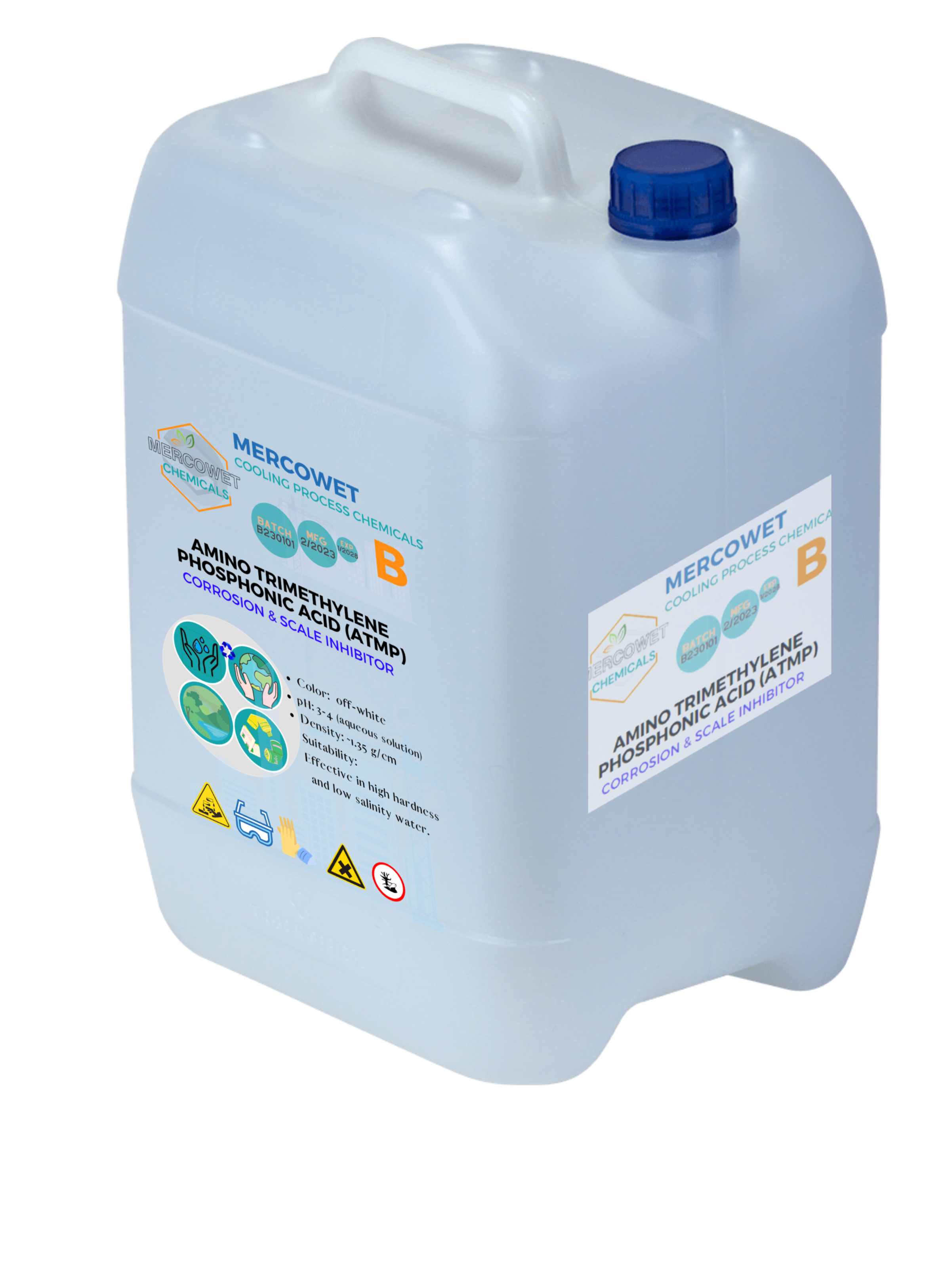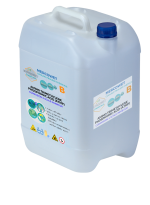Introduction: Corrosion is a critical concern in cooling tower systems, impacting their efficiency and lifespan. Low hardness water can exacerbate corrosion due to its corrosive nature, presenting challenges for maintaining system integrity. Effective corrosion inhibitors are essential for mitigating these challenges and ensuring the long-term performance of cooling tower systems.
Key Benefits:
- Prevents corrosion damage to system components
- Extends the lifespan of cooling tower equipment
- Maintains system efficiency and performance
- Reduces maintenance and repair costs
Our Solution: MERCOR Series; Phosphonate and Sulphonate Based Corrosion Inhibitors
- Formulated specifically for low & high hardness and salinity water conditions
- Provides excellent protection against corrosion
- Compatible with various system materials
- Easy to apply and monitor for optimal results
Challenges of Low Hardness Water:
- Increased risk of corrosion due to lack of buffering capacity
- Accelerated degradation of metal surfaces
- Formation of scale deposits in the absence of effective inhibitors
- Compromised system efficiency and performance over time
Why Choose Our Corrosion Inhibitors:
- Proven effectiveness in low hardness water environments
- Tailored formulations for optimal corrosion protection
- Supported by technical expertise and reliable performance
- Cost-effective solution for long-term system maintenance
Application Areas:
-
- Cooling tower recirculating systems in industrial, commercial, and institutional settings
- HVAC systems where low hardness water is a concern
- Any water-based system requiring corrosion protection in low hardness conditions
Mercowet Special Water Treatment Solution
Mercowet proudly presents the customized superb water treatment combination for different types of raw waters to be treated for re-circulating cooling process waters from low to high hardness, salinity and fouling conditions. Please send us inquiry about your water treatment requirements and financial estimations.
-
- MERCOR-LHS ; 5-10 PPL; 45-50P(C)
- MERCOR-MSM ; 10-15 PPL ; 45-50P(C&D)
- MERCOR-MSY ; 5-15 PPL ; 20 & 30P ; 40-50P(C)
- MERCOR-LHHS ; 10-15 PPL ; 45-50P (C)
- MERCOR-CS ; ; 5-10 PPL ; 45-50P (C&D)
- MERCOR-LHY-T ; 2-5 PPL ; 45-50P(C)
- MERCOR-LHY-B ; 5-10 PPL ; 48 P(C)
- MERCOR-HHLS ; 15-20 PPL; 45-50P(C )
- MERCOR-HHHS ; 15-20 PPL ; 45-50P(C)
- MERDIS-LH ; 5-10 PPL ; 40-50P(C &D)
- MERDIS-MH ; 5-15 PPL ; 45-50P(C&D)
- MERDIS-LHMP ; 2-5; 5-20 PPL ; 45-50P(C & D)
- MERDIS-HH ; 5-15 PPL ; 45-50P(C &D)
- MERDIS-YMP ; 5-10 PPL ; 20-50P(C)
- MERAS-L ; 5-15 PPL ; 45-50P(C &D)
- MERAS-H; 5-10 PPL ; 45-50P(C &D)
- MERFOU-OR-IS ; 2-5 PPL ; 10-14P(C &D)
- MERFOU-OR-CRB ; 10-50 PPL ; 20-30P (C &D)
- MERFOU-IO-MP ; 5-20 PPL(C &D)
- MERAF-LHT (C) (Anti-Freeze)
- MERAF-NLH (C) (Anti-Freeze)
- MERAC-LS ; 5-10 PPL ; 45-50P (C)
- MERAC-H ; 5-15 PPL ; 45-50P (C & D)
(C=Can; D= Drum)
Contact Us for inquiry: sales@mercowet.com
Phosphonate Based Water Treatment Products: (5-25 PPL)
- Diethylene Triamine Penta (Methylene Phosphonic Acid) (DETPMP)
- Diethylenetriamine Penta (Methylene Phosphonic Acid) (DTPMP)
- Hydroxyethylamino Di (Methylene Phosphonic Acid) (HEMPA)
- Hexamethylenediaminetetra (Methylene Phosphonic Acid) Sodium Salt (HMDTMPA-Na4)
- Tetra Potassium Salt of HEDP (HEDP-K4)
- PBTCA (2-Phosphonobutane-1,2,4-Tricarboxylic Acid)
- Diethylene Triamine Penta (Methylene Phosphonic Acid) (DETPMP)
- Polyamino Polyether Methylene Phosphonate (PAPEMP)
- Hexamethylenediamine Tetra (Methylene Phosphonic Acid) (HMDTMPA)
- Ethylenediamine Tetra (Methylene Phosphonic Acid) (EDTMPA)
- Ethylene Diamine Tetra (Methylene Phosphonic Acid) Sodium Salt (EDTMPA-Na4)
- Ethylene Diamine Tetra (Methylene Phosphonic Acid) Potassium Salt (EDTMPA-K4)
- DTPMPA (Diethylene Triamine Penta (Methylene Phosphonic Acid) Sodium Salt)
- EDTMPA-Kx (Ethylene Diamine Tetra (Methylene Phosphonic Acid) Potassium Salt)
- ATMP-Na5 (Amino Trimethylene Phosphonic Acid Pentasodium Salt)
Conventional Water Treatment Products:
- Sodium hypochlorite (CAS No. 7681-52-9): Commonly used as a disinfectant and oxidizing agent in water treatment to control microbial growth and remove organic contaminants. Concentrations typically range from 0.5% to 5%.
- Calcium hypochlorite (CAS No. 7778-54-3): Another disinfectant and oxidizing agent used for water treatment, often in solid form (granules or tablets). Concentrations vary based on application but can range from 5% to 70%.
- Chlorine dioxide (CAS No. 10049-04-4): Effective for disinfection and oxidation, particularly for controlling biofilm and pathogens. Concentrations depend on the application but may range from 0.5 to 10 ppm.
- Sodium hydroxide (CAS No. 1310-73-2): Also known as caustic soda, used for pH adjustment, water softening, and precipitation of metals. Concentrations vary widely based on application, ranging from 0.1% to 50%.
- Sulfuric acid (CAS No. 7664-93-9): A strong acid used for pH adjustment, cleaning, and scale removal. Concentrations range from dilute solutions (1-10%) to concentrated forms (>90%).
- Hydrochloric acid (CAS No. 7647-01-0): Another strong acid used for pH adjustment, cleaning, and scale removal. Concentrations vary widely, from dilute solutions (1-10%) to concentrated forms (>30%).
- Aluminum sulfate (CAS No. 10043-01-3): Commonly used as a coagulant in water treatment to clarify and remove suspended solids. Concentrations range from 1% to 30%.
- Ferric chloride (CAS No. 7705-08-0): A coagulant and flocculant used for water clarification and phosphorus removal. Concentrations vary but typically range from 5% to 40%.
- Polyaluminum chloride (CAS No. Variable): Another coagulant used for water clarification and turbidity reduction. Concentrations range from 5% to 30%.
- Sodium carbonate (CAS No. 497-19-8): Used for pH adjustment, alkalinity control, and water softening. Concentrations vary depending on the application but typically range from 0.5% to 5%.
- Sodium bicarbonate (CAS No. 144-55-8): Also known as baking soda, used for pH adjustment and alkalinity control. Concentrations range from 0.5% to 5%.
- Sodium metabisulfite (CAS No. 7681-57-4): An oxygen scavenger and dechlorination agent used in boiler water treatment. Concentrations vary but typically range from 0.1% to 5%.
- Sodium thiosulfate (CAS No. 7772-98-7): Used as a dechlorination agent and as an oxygen scavenger in water treatment. Concentrations range from 0.1% to 5%.
- Sodium silicate (CAS No. 1344-09-8): Also known as water glass, used for corrosion inhibition, scale prevention, and as a binder in coatings. Concentrations vary but typically range from 1% to 10%.
- Polyacrylamide (CAS No. 9003-05-8): A flocculant and coagulant aid used for solid-liquid separation and dewatering in wastewater treatment. Concentrations range from 0.1% to 0.5%.
- Potassium permanganate (CAS No. 7722-64-7): A strong oxidizing agent used for disinfection, odor control, and iron and manganese removal. Concentrations vary but typically range from 0.1% to 5%.
- Hydrogen peroxide (CAS No. 7722-84-1): An oxidizing agent used for disinfection, oxidation, and odor control. Concentrations vary but typically range from 3% to 30%.
- Sodium hexametaphosphate (CAS No. 10124-56-8): A sequestering agent used for scale inhibition and corrosion control in water treatment. Concentrations vary but typically range from 1% to 10%.
- Glutaraldehyde (CAS No. 111-30-8): A biocide and disinfectant used for microbial control in water systems. Concentrations vary but typically range from 0.1% to 2.5%.
- EDTA (CAS No. 60-00-4): A chelating agent used for metal ion sequestration and water softening. Concentrations vary but typically range from 0.1% to 2%.
- Sodium dichloroisocyanurate (CAS No. 2893-78-9): A disinfectant and biocide used for water disinfection and algae control. Concentrations vary but typically range from 1% to 5%.
- Sodium polyphosphate (CAS No. Variable): A sequestering agent used for scale inhibition and corrosion control. Concentrations vary but typically range from 1% to 10%.
- Bromine (CAS No. 7726-95-6): An alternative disinfectant to chlorine used for water treatment. Concentrations vary but typically range from 0.1 to 5 ppm.
- Algaecides: Various compounds, such as copper sulfate, quaternary ammonium compounds, and benzalkonium chloride, used for algae control in water systems. Concentrations vary depending on the specific algaecide and application.
- pH Buffers: Buffers such as sodium bicarbonate, sodium carbonate, and phosphate buffers used to stabilize pH levels in water treatment processes. Concentrations vary based on the desired pH range and buffering capacity needed.
- Scale Inhibitors: Compounds such as phosphonates, polyphosphates, and zinc salts used to prevent scale formation and deposition in water systems. Concentrations vary depending on the specific scale inhibitor and application.
- Corrosion Inhibitors: Compounds such as zinc salts, molybdates, and phosphates used to inhibit corrosion in water systems. Concentrations vary depending on the specific corrosion inhibitor and application.
- Dispersants: Compounds such as polyelectrolytes, lignosulfonates, and polyacrylates used to disperse suspended solids and prevent their agglomeration in water systems. Concentrations vary depending on the specific dispersant and application.
- Oxygen Scavengers: Compounds such as sodium sulfite, hydrazine, and carbohydrazide used to remove dissolved oxygen from boiler feedwater and prevent corrosion. Concentrations vary depending on the specific oxygen scavenger and application.
- Biocides: Compounds such as glutaraldehyde, isothiazolinones, and quaternary ammonium compounds used to control microbial growth and biofilm formation in water systems. Concentrations vary depending on the specific biocide and application.
- Coagulants: Compounds such as aluminum sulfate, ferric chloride, and polyaluminum chloride used to aggregate suspended solids and facilitate their removal by filtration or sedimentation. Concentrations vary depending on the specific coagulant and application.
- Flocculants: Compounds such as polyacrylamide, polyDADMAC, and starch-based polymers used to aggregate suspended solids into larger particles for easier removal by filtration or sedimentation. Concentrations vary depending on the specific flocculant and application.
- Anti-foaming Agents: Compounds such as silicone-based defoamers and non-ionic surfactants used to control foam formation in water systems. Concentrations vary depending on the specific anti-foaming agent and application.
- Antiscalants: Compounds such as phosphonates, polyphosphates, and carboxylic acids used to prevent scale formation and deposition in membrane-based water treatment systems. Concentrations vary depending on the specific antiscalant and application.
- Surfactants: Compounds such as non-ionic, anionic, and cationic surfactants used for various purposes in water treatment, including wetting, emulsification, and dispersion. Concentrations vary depending on the specific surfactant and application.
- Oxygen Scavengers: Compounds such as sodium sulfite, hydrazine, and carbohydrazide used to remove dissolved oxygen from boiler feedwater and prevent corrosion. Concentrations vary depending on the specific oxygen scavenger and application.
- Biocides: Compounds such as glutaraldehyde, isothiazolinones, and quaternary ammonium compounds used to control microbial growth and biofilm formation in water systems. Concentrations vary depending on the specific biocide and application.
- Coagulants: Compounds such as aluminum sulfate, ferric chloride, and polyaluminum chloride used to aggregate suspended solids and facilitate their removal by filtration or sedimentation. Concentrations vary depending on the specific coagulant and application.
- Flocculants: Compounds such as polyacrylamide, polyDADMAC, and starch-based polymers used to aggregate suspended solids into larger particles for easier removal by filtration or sedimentation. Concentrations vary depending on the specific flocculant and application.
- Anti-foaming Agents: Compounds such as silicone-based defoamers and non-ionic surfactants used to control foam formation in water systems. Concentrations vary depending on the specific anti-foaming agent and application.
- Antiscalants: Compounds such as phosphonates, polyphosphates, and carboxylic acids used to prevent scale formation and deposition in membrane-based water treatment systems. Concentrations vary depending on the specific antiscalant and application.
- Surfactants: Compounds such as non-ionic, anionic, and cationic surfactants used for various purposes in water treatment, including wetting, emulsification, and dispersion. Concentrations vary depending on the specific surfactant and application.
- Corrosion Inhibitors: Compounds such as zinc salts, molybdates, phosphates & advanced phosphonates, sulphonates used to inhibit corrosion in water systems. Concentrations vary depending on the specific corrosion inhibitor and application.
- Defoamers: Compounds such as silicone-based defoamers, non-ionic surfactants, and fatty alcohols used to control foam formation in water systems. Concentrations vary depending on the specific defoamer and application.
- Antiscalants: Compounds such as phosphonates, polyphosphates, and carboxylic acids used to prevent scale formation and deposition in membrane-based water treatment systems. Concentrations vary depending on the specific antiscalant and application.
- Oxygen Scavengers: Compounds such as sodium sulfite, hydrazine, and carbohydrazide used to remove dissolved oxygen from boiler feedwater and prevent corrosion. Concentrations vary depending on the specific oxygen scavenger and application.
- Biocides: Compounds such as glutaraldehyde, isothiazolinones, and quaternary ammonium compounds used to control microbial growth and biofilm formation in water systems. Concentrations vary depending on the specific biocide and application.
- Coagulants: Compounds such as aluminum sulfate, ferric chloride, and polyaluminum chloride used to aggregate suspended solids and facilitate their removal by filtration or sedimentation. Concentrations vary depending on the specific coagulant and application.
- Flocculants: Compounds such as polyacrylamide, polyDADMAC, and starch-based polymers used to aggregate suspended solids into larger particles for easier removal by filtration or sedimentation. Concentrations vary depending on the specific flocculant and application.
- Anti-foaming Agents: Compounds such as silicone-based defoamers and non-ionic surfactants used to control foam formation in water systems. Concentrations vary depending on the specific anti-foaming agent and application.












Reviews
There are no reviews yet.